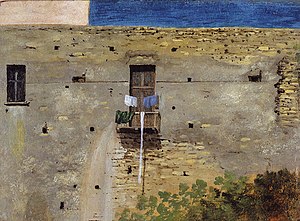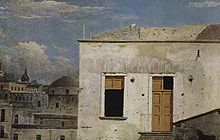Wall in Naples

|
| Wall in Naples |
|---|
| Thomas Jones , 1782 |
| Oil on paper |
| 11.4 x 16 cm |
| National Gallery, London |
Wall in Naples is the name of a painting by Thomas Jones (1742-1803) from the year 1782. The small-format oil paintings on paper is one of several open-air studies that from 1776 to 1783 on Jones' trip to Italy that arose him to Rome and Naples led . In Naples, Jones made a series of views of the city from the window or roof of his home. In 1993 the painting was acquired by the National Gallery in London .
Image description
The picture, roughly the size of a postcard, shows the outer wall of a house made of yellowish bricks , which is only partially covered by the crumbling plaster . A closed wooden door can be seen behind a small balcony in the center of the picture. Four different colored items of laundry hang over the balcony. The wall of the house under the left side of the balcony is discolored by rainwater pouring down or washing water poured out. On the left edge of the picture there is a window, on the lower right edge of the picture green leaves protrude into the picture. There are also numerous holes in the wall that were used to attach scaffolding during construction . A narrow strip of blue sky shines above the wall at the top of the picture, which is only covered on the left by the light wall of another house. No people can be seen in the picture, probably also because it shows the place at the time of the greatest midday heat, the siesta , which can also be recognized by the almost vertical shadow under the balcony. The house wall is "a wall that belonged to the rear annex of a monastery" and which could be seen from the window of the painter's studio.
reception
Jones' open-air studies from Naples remained unpublished in the family until the mid-20th century; when they came to the public at auction on July 2, 1954 at Christie's auction house in a collection of 50 of Jones' watercolors and oil paintings, this led to a complete re-evaluation of his work.
The wall in Naples painting is valued for very different reasons. Some critics express admiration for the precise craftsmanship of the picture, for the "formal challenges" conquered by Jones and not for the "inconsequential motif". The short biography of the National Gallery also emphasizes the “accuracy and immediacy” of his Naples pictures.

However, many voices also highlight the fact that Jones was breaking new ground in choosing his subject. Other landscape painters of the late 18th century could hardly do without certain recurring pictorial elements (such as ruins, people as accessories ). Her pictures reveal sublimity , show figures and situations from the myths of antiquity . What is new at Jones is that he has never before chosen painted views without any historical and mythical allusions as a motif for landscapes. Lawrence Gowing calls Jones' approach "reacting against the sublime".
In the online edition of The Guardian , Jonathan Jones writes that Thomas Jones' views of the city of Naples have the same cool, quiet enigma as pictures of Georges Seurat , Giorgio de Chirico or Edward Hopper , which were made 100 or more years later. They should be understood more as still lifes than as landscape paintings, because "the roofs and walls of Naples are arranged like bottles or bowls for the eye."
The British newspaper The Independent on Sunday features the painting in its Art - Great works series . In his article, art critic Tom Lubbock emphasizes the amazing modernity of the geometric arrangement and the random selection of a motif. According to Lubbock, the picture focuses on a sight that presents itself to us many times a day, but which rarely receives our full attention. The critic also contemplates that a wall can stand for boredom, the withdrawal of sensory impressions or the end point on a (life) path.
literature
- Busch, Werner: The sentimental picture . CH Beck Verlag, Munich 2001, ISBN 3-406-37554-5 .
- Geiger, Annette: Original image and photographic view: Diderot, Chardin and the prehistory of photography in painting in the 18th century . Wilhelm Fink Verlag, Munich 2004, ISBN 3-7705-3974-5 .
- Gowing, Lawrence: The originality of Thomas Jones . Thames and Hudson, London 1985, ISBN 0-500-55017-4 .
- Jones, Jonathan: Wonder walls. The Guardian , May 15, 2003, accessed February 12, 2010 .
- Lubbock, Tom: Jones, Thomas: A Wall in Naples (1782). The Independent , October 20, 2006, accessed February 12, 2010 .
- A Wall in Naples. National Gallery (London) , accessed February 12, 2010 .
- Thomas Jones. National Gallery (London) , accessed February 12, 2010 .
- Zuffi, Stefano: picture atlas of painting . EA Seemann Verlag, Leipzig 2004, ISBN 3-86502-095-X .
Individual evidence
- ↑ See Busch, Werner: Das sentimentalische Bild . CH Beck Verlag, Munich 2001, ISBN 3-406-37554-5 , p. 357 .
- ↑ a b Cf. Lubbock, Tom: Jones, Thomas: A Wall in Naples (1782). The Independent , October 20, 2006, accessed February 12, 2010 .
- ↑ Busch, Werner: The sentimental picture . CH Beck Verlag, Munich 2001, ISBN 3-406-37554-5 , p. 357 .
- ↑ At 14 × 21.5 cm, the format is similar to that of Mauer in Naples .
- ↑ a b See Jones, Jonathan: Wonder walls. The Guardian , May 15, 2003, accessed February 12, 2010 .
- ^ Zuffi, Stefano: picture atlas of painting . EA Seemann Verlag, Leipzig 2004, ISBN 3-86502-095-X , p. 242 .
- ↑ "[...] remarkable for their combination of precision and immediacy." Thomas Jones. National Gallery (London) , accessed February 12, 2010 .
- ↑ See "[The paintings] reject the idea - consciously shared by Jones himself - that it was previous depiction in art, and beyond that mythic and historical weight, that made a view worth recording." In: Jones, Jonathan: Wonder walls . The Guardian , May 15, 2003, accessed February 12, 2010 .
- ↑ "Reacting Against the Sublime," Gowing, Lawrence: The originality of Thomas Jones . Thames and Hudson, London 1985, ISBN 0-500-55017-4 (no page number). quoted from Geiger, Annette: Original image and photographic view: Diderot, Chardin and the prehistory of photography in painting in the 18th century . Wilhelm Fink Verlag, Munich 2004, ISBN 3-7705-3974-5 , p. 154 .
- ↑ Cf. “Here was a total mystery: an 18th-century painter whose views of Naples have the chilly, silent enigma of modernist paintings by Seurat or De Chirico or Hopper.” In: Jones, Jonathan: Wonder walls. The Guardian , May 15, 2003, accessed February 12, 2010 .
- ↑ "In the repose of a hot midday, the roofs and walls of Naples are arranged for the eye like bottles or bowls." In: Jones, Jonathan: Wonder walls. The Guardian , May 15, 2003, accessed February 12, 2010 .
- ↑ Cf. "He made about a dozen unprecedented images, simply of walls and housetops: fragmentary glimpses, strikingly modern in their random observations, their geometrical designs." In Lubbock, Tom: Jones, Thomas: A Wall in Naples (1782). The Independent , October 20, 2006, accessed February 12, 2010 .
